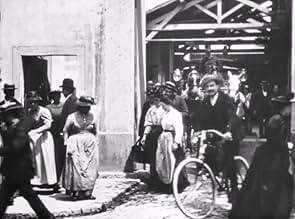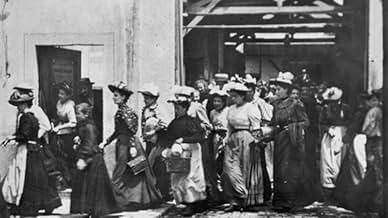Ajouter une intrigue dans votre langueWorkers leaving the Lumière factory for lunch in Lyon, France in 1895; a place of great photographic innovation and one of the birth places of cinema.Workers leaving the Lumière factory for lunch in Lyon, France in 1895; a place of great photographic innovation and one of the birth places of cinema.Workers leaving the Lumière factory for lunch in Lyon, France in 1895; a place of great photographic innovation and one of the birth places of cinema.
- Réalisation
Avis à la une
Even as the first film to come to cinema, it's still better than a lot of the films that come out today. The origin story of this film is completely fascinating. An unknowing audience attend the cinema assuming it will be a series of still images, until they get hit with the greatest twist of all time - a moving picture. The 33/100 who went to see this film are some of the luckiest people of all time, just imagine their shock.......
The appeal of ancient films like this one is that you get to see an actual moving image of life over 100 years ago. Here are a lot of people leaving a factory, all of them dead by now and none of them even remotely aware of the magnitude of the invention that they are walking before. I was shocked to read one reviewer call this film as boring as home videos today, and at least one other mistakenly identified it as the first film ever made (it was the first film made at the rate of 16 frames per second, rather than the then-normal 46 frames per second).
Sure, all you see is a lot of people filing out of a building and passing before the cinematograph on their way home from work, but this is a curiosity piece for dozens of reasons, not the least of which is that it was the first film made by the Lumiére brothers, who probably had a stronger impact on the development of the cinema than any other individual or group of individuals in history.
Sure, all you see is a lot of people filing out of a building and passing before the cinematograph on their way home from work, but this is a curiosity piece for dozens of reasons, not the least of which is that it was the first film made by the Lumiére brothers, who probably had a stronger impact on the development of the cinema than any other individual or group of individuals in history.
Story says that on that on December 28, 1895, a small group of thirty-three people was gathered at Paris's Salon Indien Du Grand Café to witness the Cinématographe, a supposedly new invention that resulted from the work done by a couple of photographers named August and Louis Lumière. The small audience reunited that day (some by invitation, most due to curiosity) didn't really know what to expect from the show, and when a stationary photograph appeared projected on a screen, most thought that the Cinématographe was just another fancy devise to present slide-show projections. Until the photograph started to move. What those thirty-three people experienced in awe that cold day of December was the very first public screening of a moving picture being projected on a screen; history was being written and cinema as we know it was born that day.
Of the 10 short movies that were shown during that historic day, "La Sortie Des Usines Lumière" (literally "Exiting the Lumière Factory") was the very first to be screened. The film shows the many workers of the Lumière factory as they walk through the gates of the factory, leaving the building at the end of a hard day of work. While a very basic "actuality film" (movie depicting a real event), the movie took everyone in the audience by surprise, as their concept of moving pictures was limited to Edison's "Peep Show" machines (the Kinetoscope), the brothers' invention was like nothing they had seen before and so the audience stood in awe, as the people and the horses moved across the screen. The idea wasn't entirely new (Le Prince shot the first movie as early as 1888), but the way of showing the movie was simply revolutionary.
"La Sortie Des Usines Lumière" would become the first in the long series of "actuality films" that the Lumière would produce over the years. This primitive form of documentary was the brothers' favorite kind of film because they were more interested in the technological aspects of their invention than in the uses the Cinématographe could have. Despite the initial lack of enthusiasm, after the first showing the Cinématographe became a great success and "La Sortie Des Usines Lumière" quickly became an iconic image of that first screening. It definitely wasn't the first movie the brothers shot that year, and it probably wasn't the best of the 10 movies shown that day (personally I think that "L' Arroseur Arrosé" was the best of the 10); however, it is really meaningful that the very first movie was the opening of a pair of gates, as literally, this movie opened the gates to cinema as we know it. 8/10
Of the 10 short movies that were shown during that historic day, "La Sortie Des Usines Lumière" (literally "Exiting the Lumière Factory") was the very first to be screened. The film shows the many workers of the Lumière factory as they walk through the gates of the factory, leaving the building at the end of a hard day of work. While a very basic "actuality film" (movie depicting a real event), the movie took everyone in the audience by surprise, as their concept of moving pictures was limited to Edison's "Peep Show" machines (the Kinetoscope), the brothers' invention was like nothing they had seen before and so the audience stood in awe, as the people and the horses moved across the screen. The idea wasn't entirely new (Le Prince shot the first movie as early as 1888), but the way of showing the movie was simply revolutionary.
"La Sortie Des Usines Lumière" would become the first in the long series of "actuality films" that the Lumière would produce over the years. This primitive form of documentary was the brothers' favorite kind of film because they were more interested in the technological aspects of their invention than in the uses the Cinématographe could have. Despite the initial lack of enthusiasm, after the first showing the Cinématographe became a great success and "La Sortie Des Usines Lumière" quickly became an iconic image of that first screening. It definitely wasn't the first movie the brothers shot that year, and it probably wasn't the best of the 10 movies shown that day (personally I think that "L' Arroseur Arrosé" was the best of the 10); however, it is really meaningful that the very first movie was the opening of a pair of gates, as literally, this movie opened the gates to cinema as we know it. 8/10
Forget the "twists" you've seen in films like Psycho (1960), The Sixth Sense(1999), and the Crying Game(1992), LEAVING THE LUMIERE FACTORY (1895) blows those plot points out of the water and takes it rightful place as the biggest shock in movie history.
December 28, 1895, The Grand Cafe' in Paris, France. Only 33 out of 100 tickets are sold to the first ever demonstration of the Lumiere Cinematograph. A jaded, French crowd sits in the theater waiting to see this mystery invention they know nothing about. The lights go down. A static, barren shot of the front door of a factory is projected onto the screen. Several seconds go by before a man stands up and shouts in disappointment, "It's just the old Magic Lantern!" (the magic lantern was a primitive slide projector for still photographs) Suddenly, the doors of the factory on screen miraculously swing open, a crowd of women pour out into the frame and a seizure of--believe it or not!--motion happens within the picture. Needless to say, the audience was caught completely off guard, and were absolutely dumbstruck.
Can you imagine it?! The audience had co clue that the picture would move! They must have went bonkers! It would be like you watching Jerry Maguire, and then Tom Cruise walks right out of the screen and sits down next to you!
When those French ladies opened the doors to the Lumiere Factory, they were also opening the doors to a whole new world of art and entertainment!
December 28, 1895, The Grand Cafe' in Paris, France. Only 33 out of 100 tickets are sold to the first ever demonstration of the Lumiere Cinematograph. A jaded, French crowd sits in the theater waiting to see this mystery invention they know nothing about. The lights go down. A static, barren shot of the front door of a factory is projected onto the screen. Several seconds go by before a man stands up and shouts in disappointment, "It's just the old Magic Lantern!" (the magic lantern was a primitive slide projector for still photographs) Suddenly, the doors of the factory on screen miraculously swing open, a crowd of women pour out into the frame and a seizure of--believe it or not!--motion happens within the picture. Needless to say, the audience was caught completely off guard, and were absolutely dumbstruck.
Can you imagine it?! The audience had co clue that the picture would move! They must have went bonkers! It would be like you watching Jerry Maguire, and then Tom Cruise walks right out of the screen and sits down next to you!
When those French ladies opened the doors to the Lumiere Factory, they were also opening the doors to a whole new world of art and entertainment!
This one-minute film is arguably the first movie ever made. Other inventors had previously filmed actions - like Edison's motion photography of a sneeze - but the Lumiere brothers developed equipment that tremendously advanced the medium. At the time, of course, their `cinematograph' must have bewildered their peers, including their subjects. In this first instance, the brothers record employees leaving their factory, some of whom understandably struggle to hide their awareness of the camera. The Lumieres attempt to make the film more entertaining by introducing animals and a bicycle, but `La Sortie Des Usines Lumiere' doesn't nearly match the ingenuity of their later films. The most interesting aspect of this short film is the brothers' selection of a familiar working class ritual as their subject. Their choice is the initial evidence of their curiosity about all of the world's people, a quality that makes viewing their experiments immensely rewarding and fascinating today.
Rating: 8
Rating: 8
Le saviez-vous
- AnecdotesIt was the first film ever to be projected to a paying audience.
- Versions alternativesThree versions of the film exist. There are a number of differences between them, such as the clothing styles worn by the workers change to reflect the different seasons the versions were shot in, and the horse-drawn carriage that appears in the first version is pulled by one horse, two horses in the second version, and no horse and no carriage in the third version.
- ConnexionsEdited into The Lumière Brothers' First Films (1996)
Meilleurs choix
Connectez-vous pour évaluer et suivre la liste de favoris afin de recevoir des recommandations personnalisées
Détails
- Date de sortie
- Pays d’origine
- Sites officiels
- Langue
- Aussi connu sous le nom de
- La sortie de l'usine
- Lieux de tournage
- Société de production
- Voir plus de crédits d'entreprise sur IMDbPro
- Durée1 minute
- Couleur
- Mixage
- Rapport de forme
- 1.33 : 1
Contribuer à cette page
Suggérer une modification ou ajouter du contenu manquant

Lacune principale
By what name was La sortie de l'usine Lumière à Lyon (1895) officially released in India in English?
Répondre



















